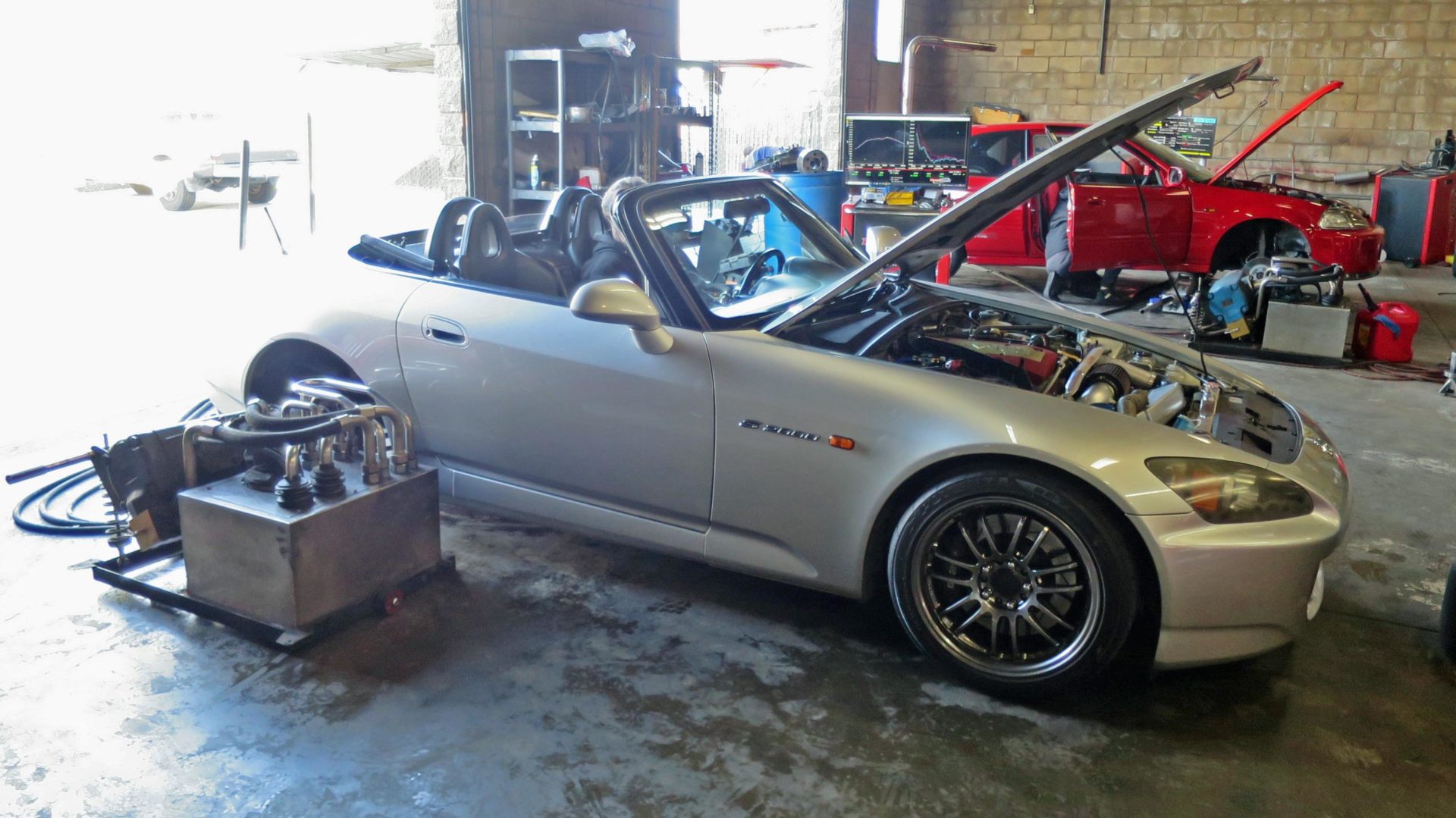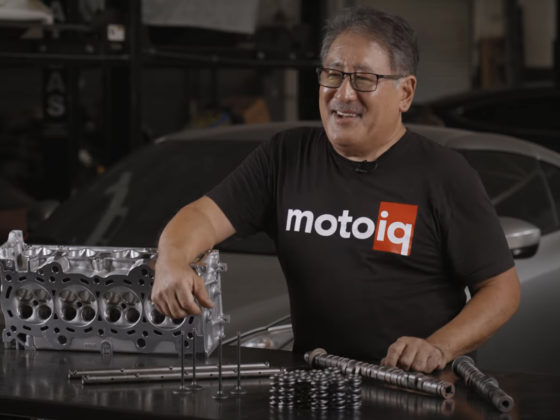 The boost solenoid duty cycle was constant from 4000rpm and up, but the boost pressure curve was not. The boost peaked at 15.0psi at 7000rpm and dropped to ~14.1psi at 8500rpm. In having driven the car a bit and taken data over a bunch of pulls, the boost achieved does vary based on intake air temperatures for a given boost solenoid duty cycle. In this particular case, I’m guessing the boost dropped because the intake air temperatures were higher at the end of the run. In a way, it’s kind of like a safety feature to automatically run less boost with hotter air temperatures to prevent detonation. Around two decades ago when I had my old turbo Nissan SE-R with HKS EVC EZ boost controller, I did notice I had to adjust it based on hot or cold weather to run the same boost level. Now I have the tools to actually datalog and see this phenomenon.
The boost solenoid duty cycle was constant from 4000rpm and up, but the boost pressure curve was not. The boost peaked at 15.0psi at 7000rpm and dropped to ~14.1psi at 8500rpm. In having driven the car a bit and taken data over a bunch of pulls, the boost achieved does vary based on intake air temperatures for a given boost solenoid duty cycle. In this particular case, I’m guessing the boost dropped because the intake air temperatures were higher at the end of the run. In a way, it’s kind of like a safety feature to automatically run less boost with hotter air temperatures to prevent detonation. Around two decades ago when I had my old turbo Nissan SE-R with HKS EVC EZ boost controller, I did notice I had to adjust it based on hot or cold weather to run the same boost level. Now I have the tools to actually datalog and see this phenomenon.

After doing the math, this is where the engine was operating on the compressor map for the G25-660. Please excuse my lack of photoshop skills; I plotted the points in a chart in Excel and overlapped onto the Garrett compressor map. I have a good margin to the surge line on the left side of the map and the peak power point is right in the middle of the peak efficiency island. I picked this size compressor because I was optimistically trying to hit 500hp. I suppose that could still happen with E85. But with the given limitations of the exhaust system which I’m not going to change, ~40lbs/min is all I’m going to use.

I plotted out the estimated turbine operating points on the turbine map. Again, please excuse the crappy photoshop skills, I know the little blue dots are a bit hard to see.
 I had to make a few assumptions to calculate the turbine pressure ratio operating points. I had to take a guess on the turbine efficiency and turbine inlet temperatures. The turbine efficiency values are higher at the lower engine speeds than what a gas stand turbine map would show you due to what’s known as the pulsation effect. A twin-scroll setup has a stronger pulsation effect and therefore higher effective turbine efficiency. That’s why twin-scroll setups spool up faster. The strength of the pulsation effect goes down with higher engine speed. The goal was to get the turbine power to match the compressor power (closely enough…) as they are connected by a shaft and the energy balance has to be maintained. The other variable that had to match was the turbine pressure ratio and corrected turbine mass flow on the turbine flow line of the Garrett turbine map for the 0.72 A/R housing. With those two constraints, I adjusted the turbine efficiency and wastegate flows to reasonable values to get the turbine power and pressure ratio to match their targets. If you want to do all the math yourself, check out the equations here.
I had to make a few assumptions to calculate the turbine pressure ratio operating points. I had to take a guess on the turbine efficiency and turbine inlet temperatures. The turbine efficiency values are higher at the lower engine speeds than what a gas stand turbine map would show you due to what’s known as the pulsation effect. A twin-scroll setup has a stronger pulsation effect and therefore higher effective turbine efficiency. That’s why twin-scroll setups spool up faster. The strength of the pulsation effect goes down with higher engine speed. The goal was to get the turbine power to match the compressor power (closely enough…) as they are connected by a shaft and the energy balance has to be maintained. The other variable that had to match was the turbine pressure ratio and corrected turbine mass flow on the turbine flow line of the Garrett turbine map for the 0.72 A/R housing. With those two constraints, I adjusted the turbine efficiency and wastegate flows to reasonable values to get the turbine power and pressure ratio to match their targets. If you want to do all the math yourself, check out the equations here.
Another assumed input was P1T which is basically the backpressure from the exhaust system. 172 kPa absolute is approximately 10psi gauge of back pressure in the exhaust system which is a fairly restrictive system. This was a pretty rough guess as to the back pressure of my exhaust system. Because of the high restriction, the engine is always operating in a negative engine delta pressure, where the exhaust side is higher pressure than the intake side. This is not good from a performance standpoint, but that’s the cost of staying quiet and clean smelling. Looking back at the dyno chart, the engine makes the same torque at 3500rpm as 8000rpm. However, at 3500rpm, it only takes 9psi of boost compared to the 14psi of boost required at 8000rpm. The exhaust is really backing things up.




16 comments
Epic build! Always love your updates. Your attention to detail and penchant for data is an inspiration. Looking forward to hearing how the “quickspool” effects things.
On a side note, I must say that I would love to see this thing with a full OE style valved* exhaust. Big pipes and cats, but giant mufflers and electronically controlled cutout! It would cost a human soul to do right but man that would just be the cherry on top of an already incredible build!
I was confused for a bit on the boost curve shape until the mention of constant duty cycle came up – I may be spoiled by having worked with stuff natively designed for turbos and forgot that PID isn’t a given. Interesting results and gratifying even from here to see what it can do, I imagine it’s far moreso on your side of the screen.
Flat torque from 3500 rpm to 8000 rpm in an f20c proves your diligence in designing the turbo system was worth the effort. great read!!!
What I’d really like to see is this with G30-660 or 770, 0.83 A/R, on a track setup with wastegate dump and bigger exhaust. it should really flow well on the top-end.
The G30 series makes me go sploosh. Once I’m done with my current turbo (Boostlab) I’ll look at the g series.
Agreed but for a street car, making that much torque that low AND being quiet is nice.
Can’t wait to read about it!!!
With the extra manifold, maybe consider consulting with Artec Performance and see if they could work with the design? I’d love to see your manifold become more readily available (or might have to shoot you an email about it)
Incredible build otherwise!
I could always sell the design I guess! The car has been a big long science project and it’s been a lot of fun.
It’s been a blast to watch it all come together I’ve been following it for years! Hoping to see an update with E85 added in one day
I would love to see the design sold and other people trying different setups with it!
Thought about testing the 0.92 A/R housing on the current setup and switching to a less restrictive exhaust ? That combined with some quickspool should wake up both the mid-range and top end. I’ve run up to 90% quickspool duty with larger turbos using the Honda-based ECU code. With this smaller turbo, you probably don’t need that much though. Try using quickspool pressure equal to wastegate pressure if targetting more than WG pressure or 1-2 psi under wastegate to prevent boost spikes.
Some tuners map in quickspool in the WG duty table and don’t use the pre-set Hondata feature. This allows you to tailor quickspool to different target pressures (boost per gear for example)
I’d go to G30-660 in 0.83AR before the G25-660 with 0.92. That G30 config would spool faster and make more power I think. I’m happy with the exhaust volume noise as it is, so no changing it. I’ve had some time to adjust the boost by gear and the settings for the quick boost. I’ll update in the next article but your recommendation of targeting around WG pressure is accurate. If you look at the screen shot of the boost settings in this article, you’ll see the targets are higher than achievable in the lower rpm range which is the alternative strategy you mentioned. I’m not sure if I like the quick spool yet, I need to get out in the canyons and see what the throttle/boost/torque modulation is like in the twisties.
Are you just set on keeping the stock axle back exhaust section or would you consider making a nice system and perhaps including a resonator or two to keep things quiet and streetable without producing so much back pressure?
I’m set on it to keep the stock/stealth appearance. I’ve been driving it a couple times a week and I honestly leave it on low boost/wastegate most of the time as most of my driving is on surface streets. I can still give it full throttle without spinning in second gear once the tires are warmed up.
Hello Khiem, i do have some questions related with an article you did back in 2012. Can you kindly email me?
Thx,
Rafael,
Spain
Awesome project. LHT Performance did a similar build and they did a custom twin exit exhaust where side is opened via vacuum/boost for sufficient flow under larger boost settings, yet still quiet like stock-ish under normal throttle low speed etc. Check it out on youtube. Can’t wait for the next iteration!
Yup, I catch their videos here and there. I’m impressed they got the internally gated turbo to fit, though they did have to compromise on the manifold design a bit. I figure a freer flowing rear exhaust section with larger diameter pipes and straight-thru mufflers would free up 20-30hp on this setup. And still be pretty quiet.